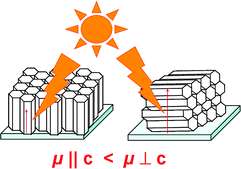The influence of the crystal orientation in porous crystalline films of ZnO electrodeposited on the photoelectrochemical characteristics of the films is studied. For differently oriented ZnO thin films following removal of the respective structure-directing agent (SDA) and adsorption of a sensitiser, time-resolved photocurrent measurements, intensity modulated photocurrent spectroscopy (IMPS), intensity modulated photovoltage spectroscopy (IMVS) and current–voltage curves were measured in acetonitrile-based electrolytes containing I3−/I− as the redox electrolyte. The crystal orientation has a significant influence on the charge transport across such films and hence is reflected in the observed electrode kinetics. Films originally grown in the presence of, e.g., Coumarin 343 as a SDA, showed a significantly faster response to illumination. Increased electron diffusion coefficients and diffusion lengths were calculated from the results of IMPS and IMVS, caused by a faster electron movement in the films. Implications of these findings on further improvements of sensitised ZnO films prepared by electrochemical deposition are discussed.

You have access to this article
 Please wait while we load your content...
Something went wrong. Try again?
Please wait while we load your content...
Something went wrong. Try again?


 Please wait while we load your content...
Please wait while we load your content...